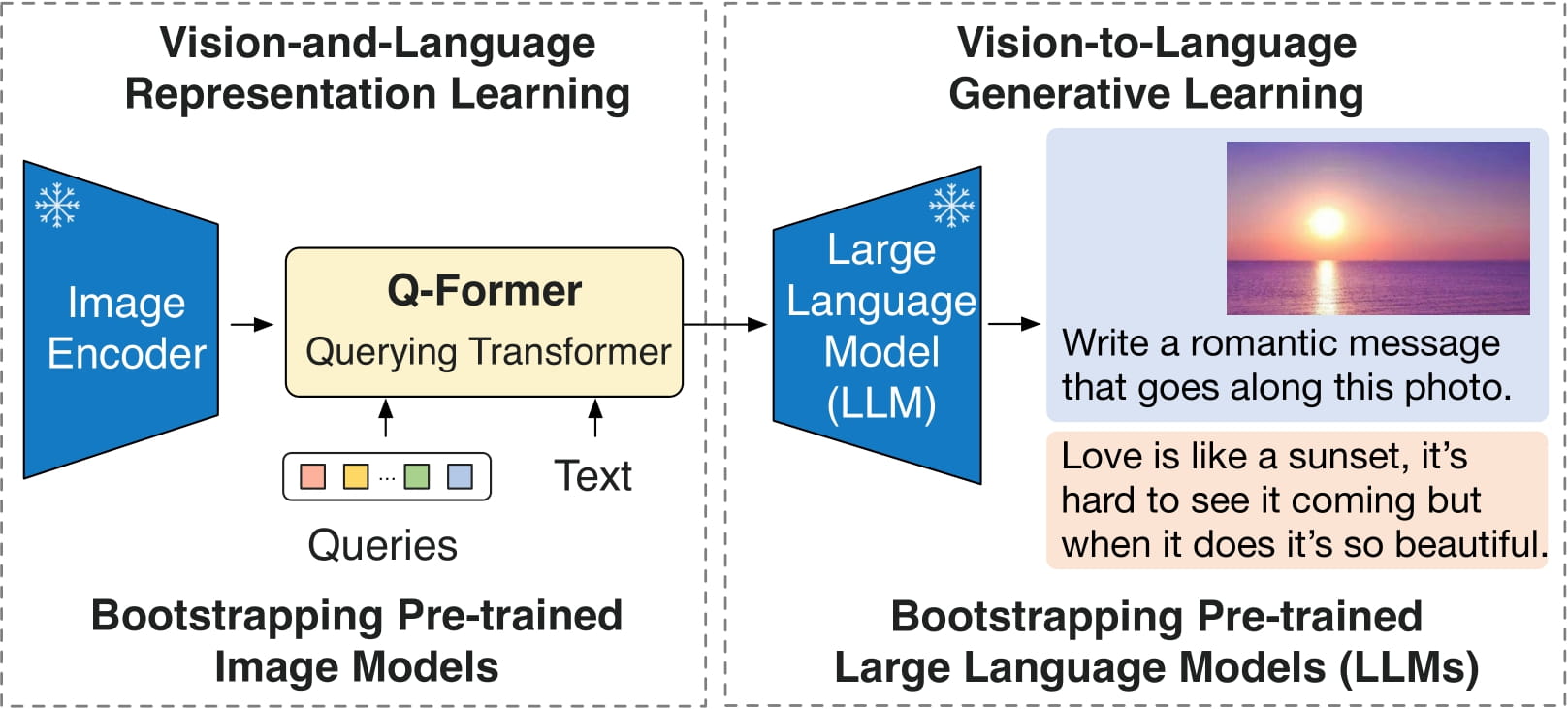# BLIP-2
## Overview
The BLIP-2 model was proposed in [BLIP-2: Bootstrapping Language-Image Pre-training with Frozen Image Encoders and Large Language Models](https://arxiv.org/abs/2301.12597) by
Junnan Li, Dongxu Li, Silvio Savarese, Steven Hoi. BLIP-2 leverages frozen pre-trained image encoders and large language models (LLMs) by training a lightweight, 12-layer Transformer
encoder in between them, achieving state-of-the-art performance on various vision-language tasks. Most notably, BLIP-2 improves upon [Flamingo](https://arxiv.org/abs/2204.14198), an 80 billion parameter model, by 8.7%
on zero-shot VQAv2 with 54x fewer trainable parameters.
The abstract from the paper is the following:
*The cost of vision-and-language pre-training has become increasingly prohibitive due to end-to-end training of large-scale models. This paper proposes BLIP-2, a generic and efficient pre-training strategy that bootstraps vision-language pre-training from off-the-shelf frozen pre-trained image encoders and frozen large language models. BLIP-2 bridges the modality gap with a lightweight Querying Transformer, which is pre-trained in two stages. The first stage bootstraps vision-language representation learning from a frozen image encoder. The second stage bootstraps vision-to-language generative learning from a frozen language model. BLIP-2 achieves state-of-the-art performance on various vision-language tasks, despite having significantly fewer trainable parameters than existing methods. For example, our model outperforms Flamingo80B by 8.7% on zero-shot VQAv2 with 54x fewer trainable parameters. We also demonstrate the model's emerging capabilities of zero-shot image-to-text generation that can follow natural language instructions.*
Tips:
- BLIP-2 can be used for conditional text generation given an image and an optional text prompt. At inference time, it's recommended to use the [`generate`] method.
- One can use [`Blip2Processor`] to prepare images for the model, and decode the predicted tokens ID's back to text.
 BLIP-2 architecture. Taken from the original paper.
This model was contributed by [nielsr](https://huggingface.co/nielsr).
The original code can be found [here](https://github.com/salesforce/LAVIS/tree/5ee63d688ba4cebff63acee04adaef2dee9af207).
## Resources
A list of official Hugging Face and community (indicated by 🌎) resources to help you get started with BLIP-2.
- Demo notebooks for BLIP-2 for image captioning, visual question answering (VQA) and chat-like conversations can be found [here](https://github.com/NielsRogge/Transformers-Tutorials/tree/master/BLIP-2).
If you're interested in submitting a resource to be included here, please feel free to open a Pull Request and we'll review it! The resource should ideally demonstrate something new instead of duplicating an existing resource.
## Blip2Config
[[autodoc]] Blip2Config
- from_vision_qformer_text_configs
## Blip2VisionConfig
[[autodoc]] Blip2VisionConfig
## Blip2QFormerConfig
[[autodoc]] Blip2QFormerConfig
## Blip2Processor
[[autodoc]] Blip2Processor
## Blip2VisionModel
[[autodoc]] Blip2VisionModel
- forward
## Blip2QFormerModel
[[autodoc]] Blip2QFormerModel
- forward
## Blip2Model
[[autodoc]] Blip2Model
- forward
- get_text_features
- get_image_features
- get_qformer_features
## Blip2ForConditionalGeneration
[[autodoc]] Blip2ForConditionalGeneration
- forward
- generate
BLIP-2 architecture. Taken from the original paper.
This model was contributed by [nielsr](https://huggingface.co/nielsr).
The original code can be found [here](https://github.com/salesforce/LAVIS/tree/5ee63d688ba4cebff63acee04adaef2dee9af207).
## Resources
A list of official Hugging Face and community (indicated by 🌎) resources to help you get started with BLIP-2.
- Demo notebooks for BLIP-2 for image captioning, visual question answering (VQA) and chat-like conversations can be found [here](https://github.com/NielsRogge/Transformers-Tutorials/tree/master/BLIP-2).
If you're interested in submitting a resource to be included here, please feel free to open a Pull Request and we'll review it! The resource should ideally demonstrate something new instead of duplicating an existing resource.
## Blip2Config
[[autodoc]] Blip2Config
- from_vision_qformer_text_configs
## Blip2VisionConfig
[[autodoc]] Blip2VisionConfig
## Blip2QFormerConfig
[[autodoc]] Blip2QFormerConfig
## Blip2Processor
[[autodoc]] Blip2Processor
## Blip2VisionModel
[[autodoc]] Blip2VisionModel
- forward
## Blip2QFormerModel
[[autodoc]] Blip2QFormerModel
- forward
## Blip2Model
[[autodoc]] Blip2Model
- forward
- get_text_features
- get_image_features
- get_qformer_features
## Blip2ForConditionalGeneration
[[autodoc]] Blip2ForConditionalGeneration
- forward
- generate BLIP-2 architecture. Taken from the original paper.
This model was contributed by [nielsr](https://huggingface.co/nielsr).
The original code can be found [here](https://github.com/salesforce/LAVIS/tree/5ee63d688ba4cebff63acee04adaef2dee9af207).
## Resources
A list of official Hugging Face and community (indicated by 🌎) resources to help you get started with BLIP-2.
- Demo notebooks for BLIP-2 for image captioning, visual question answering (VQA) and chat-like conversations can be found [here](https://github.com/NielsRogge/Transformers-Tutorials/tree/master/BLIP-2).
If you're interested in submitting a resource to be included here, please feel free to open a Pull Request and we'll review it! The resource should ideally demonstrate something new instead of duplicating an existing resource.
## Blip2Config
[[autodoc]] Blip2Config
- from_vision_qformer_text_configs
## Blip2VisionConfig
[[autodoc]] Blip2VisionConfig
## Blip2QFormerConfig
[[autodoc]] Blip2QFormerConfig
## Blip2Processor
[[autodoc]] Blip2Processor
## Blip2VisionModel
[[autodoc]] Blip2VisionModel
- forward
## Blip2QFormerModel
[[autodoc]] Blip2QFormerModel
- forward
## Blip2Model
[[autodoc]] Blip2Model
- forward
- get_text_features
- get_image_features
- get_qformer_features
## Blip2ForConditionalGeneration
[[autodoc]] Blip2ForConditionalGeneration
- forward
- generate
BLIP-2 architecture. Taken from the original paper.
This model was contributed by [nielsr](https://huggingface.co/nielsr).
The original code can be found [here](https://github.com/salesforce/LAVIS/tree/5ee63d688ba4cebff63acee04adaef2dee9af207).
## Resources
A list of official Hugging Face and community (indicated by 🌎) resources to help you get started with BLIP-2.
- Demo notebooks for BLIP-2 for image captioning, visual question answering (VQA) and chat-like conversations can be found [here](https://github.com/NielsRogge/Transformers-Tutorials/tree/master/BLIP-2).
If you're interested in submitting a resource to be included here, please feel free to open a Pull Request and we'll review it! The resource should ideally demonstrate something new instead of duplicating an existing resource.
## Blip2Config
[[autodoc]] Blip2Config
- from_vision_qformer_text_configs
## Blip2VisionConfig
[[autodoc]] Blip2VisionConfig
## Blip2QFormerConfig
[[autodoc]] Blip2QFormerConfig
## Blip2Processor
[[autodoc]] Blip2Processor
## Blip2VisionModel
[[autodoc]] Blip2VisionModel
- forward
## Blip2QFormerModel
[[autodoc]] Blip2QFormerModel
- forward
## Blip2Model
[[autodoc]] Blip2Model
- forward
- get_text_features
- get_image_features
- get_qformer_features
## Blip2ForConditionalGeneration
[[autodoc]] Blip2ForConditionalGeneration
- forward
- generate